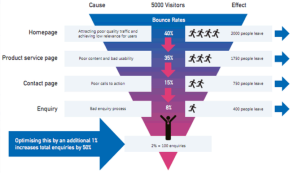Revisit your revenue model to creatively adapt to users who are increasingly embracing ad blockers. It’s time to try whitelisting and native advertising.
Content is king but it doesn’t funnel money directly into your bank account (it takes time). Ads do.
Every marketer, given their choice, could sell ads on their page if people would let them.
Unfortunately, that choice is increasingly shifting to users through their use of ad blockers.
A recent survey from Visual Objects outlined the three main reasons people use ad blockers:
- Limit interruptions
- Increase control over online experience
- Avoid irrelevant ads
Marketers need to take these reasons into accounts when considering how they plan to structure their site’s online advertising to respond to users who increasingly embrace ad blockers.
Ad blockers are growing, putting pressure on marketers
The number of people using ad blockers is growing.
Recent research illustrates the adoption of ad blockers among online users:
- 40 percent of people had used an ad blocker in the past month, mostly on desktop (PageFair, 2017)
- Three-fourths of people engage in at least one form of regular ad blocking (Deloitte, 2018)
As popular awareness of ad blocking increases across all platforms, marketers are put in a bind: how to balance their duty to earn meaningful engagement and maintain revenue without sacrificing user experience.
Revisiting how to advertise online
Historically speaking, people generally have willing to put up with ads if they get a fair trade-off – that is, relevant, quality content.
In the same historical sense, it’s been marketers’ jobs to identify the threshold of what audiences are willing to endure to view their content.
The balance of this game, of course, is to not push it too much with ads so that people bounce off your site.
Ad blocking, though, uproots those trends.
This sounds scary – and it is, but it’s simply reality. Given this, marketers should take this circumstance as an opportunity to revisit their online revenue model and creatively adapt to users who are increasingly embracing ad blockers.
Consider the following approaches to sustain online ad revenue:
1. Ask for whitelisting
Asking users to consider whitelisting your site is a transparent method to address the problem that doesn’t require you to change your advertising model.
Ads do not bother everyone, particularly if they are embedded on web pages that they value. These users deem ads “acceptable,” and are willing to endure advertising to consume their desired content.
While this approach recognizes an issue people have with online ads – the lack of control over their online experience – it doesn’t address the core issue people have with online ads: limiting interruptions.
This approach, then, means taking a loss in ad revenue. There will be some users who are not willing to sacrifice the user experience of ad-less free content if they have a choice.
2. Block your content
Blocking your page content in exchange for allowing ads is aggressive, but can be effective for sites with high demand for their content.
Recent trends in subscription-based services suggest that there is a market of people willing to pay to access content.
This seems like an enticing option since you aren’t asking your customers to explicitly pay for anything, rather to accept being exposed to ads.
Spotify is the latest high-profile example to experiment with this strategy when it updated its terms of service to block ad blockers.
The low risk of users allowing access to ads, though, doesn’t mean blocking ad blockers is a strategy without risk. Not every company is Spotify.
For some companies, the risk of users bouncing off as soon as they hit a content wall is simply too high.
3. Consider new forms of advertising
Native advertising is an alternative to banner or pop-up ads in your site. Native ads aren’t always blocked by ad-blocking software and don’t stick out as much as other forms of online advertising.
They can, however, sacrifice the integrity of your site without proper disclosure – you need to be very transparent about the content on your site is advertorial and which is not.
You also need to be very intentional about the ads you choose to include. Native advertising is a very selective game: the content needs to be as relevant to your audience as the content on your page.
If you embed native advertising that your users consider irrelevant – you validate their existing complaint that online ads are irrelevant or annoying.
Marketers need a plan to address ad blockers
Ad blockers are not going away. The worst thing you can do is be unprepared for the potential impact they can have on your user experience.
For marketers who are tasked with balancing online revenue with high-quality engagements online, this means thinking critically about your options.
The three options listed above all have benefits, granted you approach them with diligence. Study how you can use them most effectively to maintain online ad revenue.
Opinions expressed in this article are those of the guest author and not necessarily Marketing Land. Staff authors are listed here.
Marketing Land – Internet Marketing News, Strategies & Tips
(52)
Report Post








